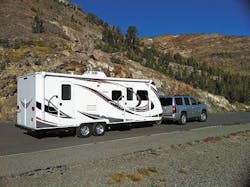New RV Industry Standard Will Drive a Shift to Radial ST Tires
As of Sept. 1, 2017, newly manufactured towable recreation vehicles (RVs) with 13-inch and larger wheels must ride on radial, not bias, tires.
A new standard requires conventional travel trailers, fifth-wheel travel trailers and folding camping trailers be outfitted with radial tires. The standard may require aftermarket tire dealers to rethink inventories of special trailer (ST) tires.
The Recreation Vehicle Industry Association (RVIA) has mandated that its member companies equip towable RVs manufactured after Sept. 1, 2017, with radial tires. Bias ply tires are not permitted on towable RVs with 13-inch or larger wheels. The standard covers virtually all new towable RV units as the RVIA represents more than 98% of total production of recreation vehicles.
The standard was developed by the National Fire Protection Association and adopted by the RVIA. Although the standard does not apply to aftermarket tire dealers, Bruce Hopkins, who is vice president of standards and education for the RVIA, believes independent tire dealers will follow his association’s lead.
“There’s no requirement for tire dealers to install replacement radial tires, but I would think they would want to. Trailers, depending on their size, have six, four or two tires. If a trailer comes in with radial tires, dealers are not going to want to replace them with bias tires.”
Mandate addresses safety concerns
Hopkins says the National Highway Traffic Safety Administration (NHTSA) identified tire failure as a key safety issue for RVs. The RVIA determined the best way to address the issues raised by NHTSA was to ban bias ply tires and provide a 10% reserve weight capacity so tires are not the weakest link in the RV’s undercarriage system.
“We take a look at the rating of the axle and then based on the rating of the axle the tires have to be 10% greater than the axle rating,” says Hopkins.
He says trailer overloading, not tire quality, leads to ST tire failures. “People have a tendency to load recreation vehicles beyond their capacity. They never think about the weight and as a result they overload the wheels and tires on one side of an RV.” The reserve weight capacity requirement also will help prevent tire failures caused by under or over inflation.
The RV market is in its eighth straight year of expansion. The industry expects to ship 472,200 units in 2017, a 9.6% increase from the number shipped in 2016. The RVIA forecasts a new peak in 2018, with production of 487,200 RV units.
Some ST tires are excluded
The new RVIA standard does not apply to tires on utility trailers and enclosed cargo trailers. But Joe Ostrowski says American Kenda Rubber Industrial Co. Ltd., which does business as Kenda USA, is seeing a strong move toward radials in the manufacture of boat trailers and enclosed trailers. He is sales manager for Kenda’s Americana Tire Division. There are two reasons behind the shift. “Number one, the pricing has gotten closer between radial and the bias. Number two, it’s a perceived improvement among consumers,” he says.
“The tire dealer is going to see fewer and fewer people wanting to see a bias replacement. If consumers look at their camper, it’s going to have radials on it, so they are going to want to stay radial.”
He feels bias tires will “never go away” for the landscaping contractor, but he expects closed trailer manufacturers will switch to radials. “I’m dealing now with people making closed trailers and more and more of them are saying we’re going ahead with radial because prices are close enough and we only have to stock one product.”
Among consumers, “there’s definitely a perceived value in the radial,” says Ostrowski. “You’re going to see more and more of that; if I were a dealer, I would stock radial.” ■
About the Author

Ann Neal
Ann Neal is a former senior editor at Modern Tire Dealer.
